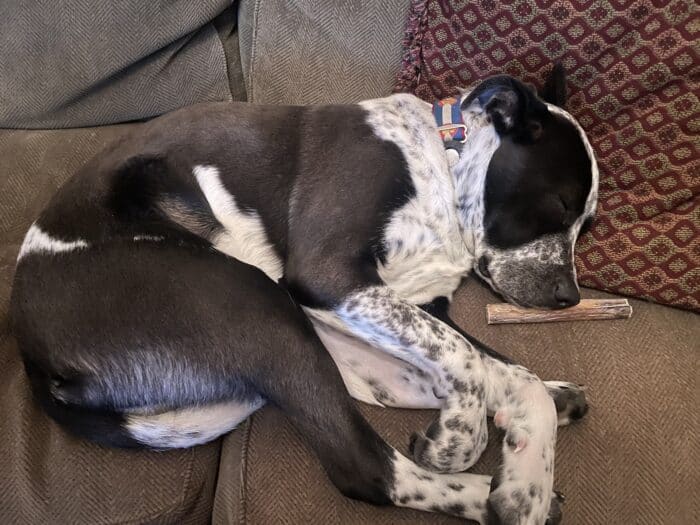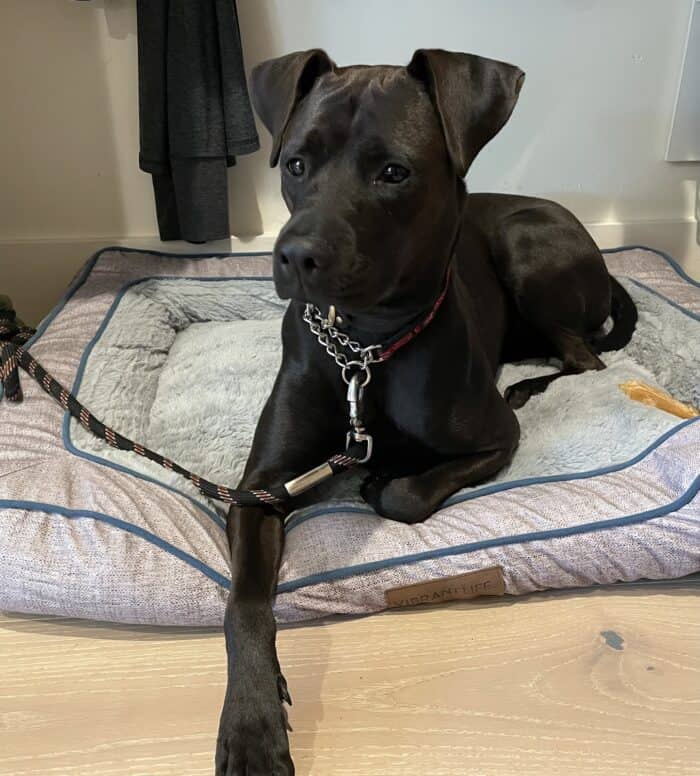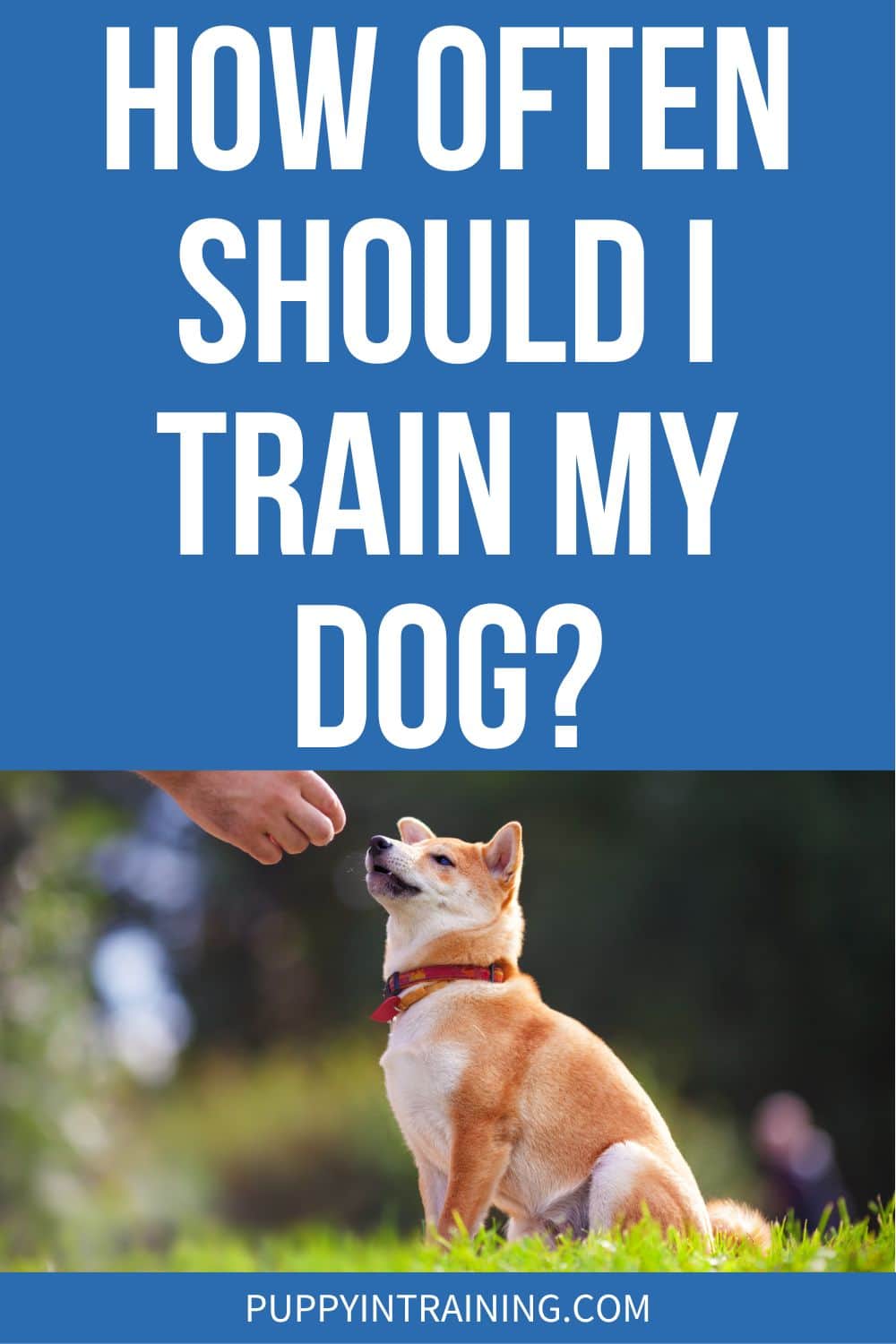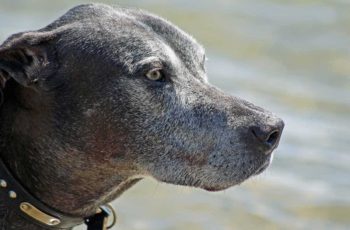This post may contain affiliate links. We may earn money or products from the companies mentioned in this post.
I often get asked by my clients how many times they should train their dog in a day or week and how much they should train between professional dog training sessions.
Some people believe the more training the better or the longer your training session the better. This way of thinking is not always true.
Dogs being trained for service, police work or the military may train for at least an hour a day and often times more, however, shorter sessions look to get the best results.

I am going to give you some tips answering the questions:
- How often should I train my dog and
- For how long to get the most benefit out of your training sessions.
Do I need to train my dog daily?
This is a tricky question. Studies have shown that it is better to pick a few days out of the week to do formal training with your dog.
My answer to this with my clients is to have them choose several days to work on specific behaviors but to also have them incorporate their training into their daily lives.
I have a client whose dog Murphy is learning the “Stay” command. Each day, I have the owner tell Murphy to “Stay” at meal times.
The command is given while the food is prepared and put down. If Murphy gets up, they simply place him back and give the command again.
Once he is able to wait patiently, he is released to his bowl of food.
This is not a formal training session per say, but it is using real life situations to teach your dog how to behave.
Quick Pro Trainer Tip: I tell my clients to ask their dog to do a small bit of work before they give their dog what they want. An example of this would be teaching your dog to ‘Heel”. I have my clients tell their dog to “Heel” at the beginning of the walk for a short distance, and then release them to the end of the leash or off-leash if they are able.
The benefits of only training several times a week:
The idea behind only training several times a week is that it gives the dog time to “digest” and understand what it has been taught.
Sleep is also very important in the learning process for dogs, so this gives the dog time to rest and “rehearse” what they have been taught while they sleep.

When training my dogs for movies, I found this to be true. I would train a behavior during the day and sometimes feel as though we had not made much progress.
After a good night’s sleep, the dog would start the next day performing the behavior perfectly as if we had practiced all night.
Another theory in favor of less frequent training sessions is that the dog is more focused and “thinking” through the training session rather than the behavior being just automatic.
Planning frequency of training and length of sessions:
Now that we know fewer formal training sessions in the week are better, we can plan a schedule for the week and decide on the length of each training session.
As I said above, pick two or three days of the week to train a behavior. It is best to spread the days out so they are not back to back.
As I said before, it is important to use what you’re teaching your dog in real world situations to reinforce the behavior.
When deciding on how long to train, take into consideration the age of your dog, the difficulty of the behavior you are training and the temperament of your dog.
I recommend planning to spend about 15 minutes in your training session at a time. If you are training a puppy or a dog easily distracted, plan a little shorter session.
Quick Pro Trainer tip: Always end your training session in a positive way even if this means taking a step back from your planned goal for that session. It is important for the dog to always feel as though they have succeeded and end their session positively and looking forward to the next session.
When planning your session, focus on one command at a time. A quick, intense, positive session helps your dog stay motivated, focused and retain what you have taught in a particular session.
I recommend to plan several training sessions on the days you train and it is fine to train more than one command within that day, but focus on only one behavior per session.
Revisit the behaviors on different days to remind your dog where you left off the last time you trained.

When to plan your training after a professional training session:
I have a lot of clients who are unsure what to do after they have had a professional training session with me.
Here are a few suggestions that will help your dog retain what has been taught in the session and will move your training forward in preparation for your next session.
First:
It is important to use what you have worked on right away in your home and in your everyday life so both you and your dog become comfortable with the behavior.
You are working to get the behavior to be second nature to both of you and not just something you use in a training session.
Second:
Working on the behavior at home reinforces to your dog that you are someone to be listened to.
I have had many clients who have not worked on the behaviors between sessions and their dog does not advance and does not listen to them outside of the session.
Depending on the complexity of the behavior you are working on, twice a week with your professional trainer is sufficient if you are taking the steps I recommended above.
Last:
After you have left your professional dog training session and practiced at home, it is important to add distractions and difficulty to the behaviors.
An example might be teaching your dog to “Heel”. Once your dog has mastered this concept, take them outside to a more crowded area where their focus will be tested.
The next step from there would be to begin trying the command “Heel” off leash in a small, secure area.
This way, you are reinforcing what they already know, and adding onto their knowledge.
By the next professional training session, you can move forward with this behavior or move onto another behavior you wish to master.
Rapid Fire Questions:
Is it bad to stop my training session if my dog seems frustrated or has lost interest?
It is important to always plan your training session with your dog’s age, temperament and the behavior you are working on in mind.
If it is a young dog, plan for a short, positive session and the same goes for a dog that gets easily distracted.
If you feel as though the dog is getting frustrated or you are not progressing in your session, look for a good time to end without just quitting.
The best way to handle this is to make the behavior somewhat easier, or backtrack to a place where you know your dog can succeed.
Ask your dog to complete the easier behavior and then end the session positively and with your dog feeling confident.
Is it possible to train my dog too much?
Yes, training sessions are best planned short and multiple times a day. It is always important to be connected to your dog and see how they are feeling.
If your dog is enthusiastic and excited to learn, take advantage of that and have some fun training together.
If your dog seems to be reluctant or uninterested, try to find ways to make your session fun and always end positively.
Final Thoughts:
I hope this information on training length and frequency is helpful.
When working with your dog, always be consistent and persistent and use what you both have learned in your normal daily activities.
To keep your dog’s interest during your training sessions, it is good to have treats that they enjoy and try to stay positive even if one or both of you gets frustrated.
Training should always be enjoyable and if you are having a hard time finding time to train your dog daily or between professional training sessions, don’t put stress or pressure on yourself.
Your dog will progress even if you don’t get to train as often as you would like.
The time spent with your dog will create a wonderful relationship and bond.
The language and signals you teach your dog in your training sessions create a way for the two of you to communicate and have a better understanding of each other.
Enjoy all the time you get to spend together.
How about you?
How often do you train your dog?
Tell us about your dog in the comment section below.
Save To Pinterest

Top Picks For Our Puppies
- BEST PUPPY TOY
We Like: Calmeroos Puppy Toy w/ Heartbeat and Heat Packs – Perfect for new puppies. Helps ease anxiety in their new home. - BEST DOG CHEW
We Like: Mighty Paw Naturals Bully Sticks – All of our puppies love to bite, nip, and chew. We love using Bully Sticks to help divert these unwanted behaviors. - BEST DOG TREATS
We Like: Crazy Dog Train-Me Treats – We use these as our high-value treats for our guide dog puppies. - BEST FRESH DOG FOOD
We Like: The Farmer’s Dog – A couple months ago we started feeding Raven fresh dog food and she loves it! Get 50% off your first order of The Farmer’s Dog.
Check out more of our favorites on our New Puppy Checklist.


